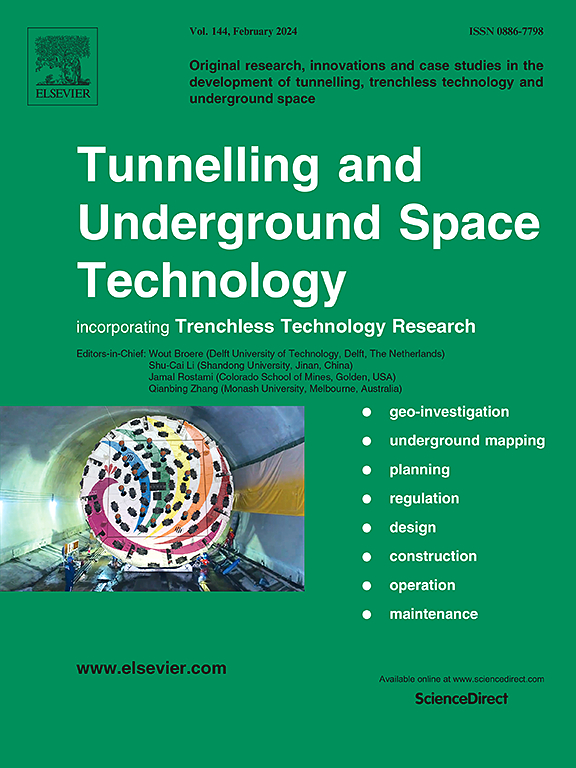Characterizing the driving cognition within spiral tunnels based on SER principle
IF 6.7
1区 工程技术
Q1 CONSTRUCTION & BUILDING TECHNOLOGY
引用次数: 0
Abstract
Spiral tunnels, increasingly used in mountainous expressways to traverse significant elevation differences, are frequently associated with traffic safety concerns due to their extended, continuous turns, which can impair driving cognition. Guided by the self-explaining road (SER) principle (Theeuwes, 2021) – which advocates environmental design that enables adequate and swift perception – this study examined both the cognitive characteristics of driving in spiral tunnels and the influence of environment on driving cognition. We first investigated the cognitive significance of tunnel environmental elements through a questionnaire survey, then conducted curvature perception experiments with 20 drivers using real-world driving videos to test fixation duration, fixation number, degree of curvature illusion, and reaction time, and finally analyzed the relations of these indicators. Results showed that compared to ordinary curved tunnels, spiral tunnels induced shorter fixation durations, lower curvature estimation (3.69 %) and prolonged reaction time (39.8 s). Entrance section triggered the longest reaction time (29.9 s) due to attention dispersion, while exit zones exhibited the most serious curvature illusion (28 %). Although the orientation of roadway (OR) was considered the most critical element, environmental elements have complex relationship with visual attention in spiral tunnels. Additionally, fixation duration and number exhibit a negative correlation with curvature illusion reaction time, suggesting adequate environmental information may improve curvature perception. The results reveal that driving cognition in spiral tunnels faces more unfavorable conditions, especially in the entrance and exit sections. Moderate supplementation of environmental information may optimize driving cognition. This study provides stakeholders with cognition-informed optimization strategies for traffic safety in geometrically constrained environments.
基于SER原理的螺旋隧道驾驶认知表征
螺旋隧道越来越多地应用于山区高速公路,因为它们的延伸,连续转弯,可能会损害驾驶认知,经常与交通安全问题有关。在自解释道路(SER)原则(Theeuwes, 2021)的指导下(该原则主张环境设计能够实现充分和快速的感知),本研究考察了螺旋隧道中驾驶的认知特征以及环境对驾驶认知的影响。首先通过问卷调查的方式考察隧道环境要素的认知意义,然后利用真实驾驶视频对20名驾驶员进行曲率感知实验,测试注视时间、注视次数、曲率错觉程度和反应时间,并分析这些指标之间的关系。结果表明,与普通弯曲隧道相比,螺旋隧道的注视时间较短,曲率估计较低(3.69%),反应时间较长(39.8 s),其中入口段由于注意力分散导致反应时间最长(29.9 s),出口段曲率错觉最严重(28%)。虽然巷道方向被认为是最关键的因素,但在螺旋隧道中,环境因素与视觉注意有着复杂的关系。此外,注视时间和注视次数与曲率错觉反应时间呈负相关,表明充足的环境信息可以改善曲率知觉。结果表明,螺旋隧道的行车认知面临着更为不利的条件,尤其是在入口和出口路段。适度补充环境信息可优化驾驶认知。本研究为利益相关者在几何约束环境下的交通安全提供了认知知情的优化策略。
本文章由计算机程序翻译,如有差异,请以英文原文为准。
求助全文
约1分钟内获得全文
求助全文
来源期刊

Tunnelling and Underground Space Technology
工程技术-工程:土木
CiteScore
11.90
自引率
18.80%
发文量
454
审稿时长
10.8 months
期刊介绍:
Tunnelling and Underground Space Technology is an international journal which publishes authoritative articles encompassing the development of innovative uses of underground space and the results of high quality research into improved, more cost-effective techniques for the planning, geo-investigation, design, construction, operation and maintenance of underground and earth-sheltered structures. The journal provides an effective vehicle for the improved worldwide exchange of information on developments in underground technology - and the experience gained from its use - and is strongly committed to publishing papers on the interdisciplinary aspects of creating, planning, and regulating underground space.
 求助内容:
求助内容: 应助结果提醒方式:
应助结果提醒方式:


